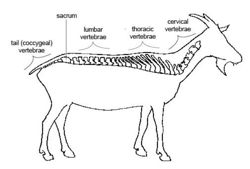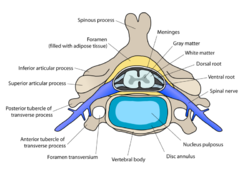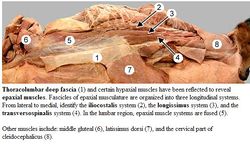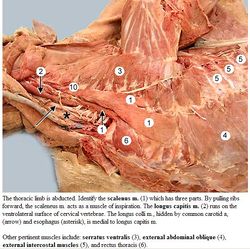Difference between revisions of "Spinal Column - Anatomy & Physiology"
m (Unprotected "Spinal Column - Anatomy & Physiology") |
Fiorecastro (talk | contribs) |
||
| (12 intermediate revisions by 4 users not shown) | |||
| Line 1: | Line 1: | ||
| − | {{ | + | {{OpenPagesTop}} |
| − | + | ==Introduction== | |
| − | |||
| − | |||
| − | |||
| − | |||
| − | |||
| − | |||
[[Image:Anatomy_and_physiology_of_animals_Regions_of_a_vertebral_column.jpg|thumb|right|250px|Divisions of the spinal cord- Copyright Ruth Lawson Otago Polytechnic ]] | [[Image:Anatomy_and_physiology_of_animals_Regions_of_a_vertebral_column.jpg|thumb|right|250px|Divisions of the spinal cord- Copyright Ruth Lawson Otago Polytechnic ]] | ||
| + | The trunk consists of three segments; the thorax, the abdomen, and the pelvis, each of which is bounded by body wall and contains a cavity. The thoracic cavity lies cranial to the diaphragm, whereas the abdominal cavity lies caudal. The pelvic cavity is defined by the borders of the bony pelvis and communicates with the abdominal cavity. Dorsally, the roof of all three cavities is formed by the spinal column and associated muscles. Vertebrae develop segmentally from '''somitic sclerotomes''', whereas muscles develop from '''somitic myotomes'''. Within each myotome is a single nerve leaving the central neural tube. Motor innervation in the adult is therefore segmental. The ventral and lateral body walls are initially formed by '''somatopleure''' (ectoderm and lateral plate mesoderm), but is later invaded by somitic cells migrating ventrally. These differentiate to form ribs and sternum and associated muscles. | ||
| + | |||
| + | ==Divisions and Landmarks== | ||
| + | The common pattern of canine landmarks, according to Dyce, Sack, et al, can be identified as: | ||
| + | [[Image:Spinal landmarks.jpg|center|500px|Spinal Landmarks - Copyright Becky Pocock 2008]] | ||
| − | = | + | ==Vertebrae and Joints== |
| − | + | [[Image:Cervical Vertebra.png|thumb|right|250px|Cervical Vertebra - Wikimedia Commons 2008]] | |
| + | Vertebrae consist of a body, which encloses the vertebral foramen (through which the spinal cord and meninges run), a spinous process, and a transverse process, as well as articular processes by which they join together. The form of the spinous process varies with respect to species and region. | ||
| − | + | ===Cervical Vertebrae=== | |
| − | The ventral and | + | The first two cervical vertebrae are known as the '''atlas''' and the '''axis''' respectively, and are modified to allow movement of the head. The atlas has no conventional body, instead it is composed of two lateral masses joined by dorsal and ventral arches. The atlas and axis are fused in embryonic life. The '''wing of the atlas''' is the transverse process of this vertebra and allows the spinal column to articulate with the skull, by providing a resting place for the occipital condyles. The axis is the longest vertebra. The '''nuchal ligament''' connects the spinous process of the axis to the spinous process of the first thoracic vertebra (T1). The last (C7) cervical vertebra has a taller spinous process than those preceding it, and articulates with the first pair of ribs. |
| − | ='' | + | ===Thoracic Vertebrae=== |
| − | The | + | |
| − | [[ | + | Thoracic vertebrae articulate with the ribs. They are distinguished by short bodies with flattened extremities, costal facets, short transverse processes and prominent spinous processes. They reach a maximum height, a few vertebrae behind the cervicothoracic junction (constituting the '''withers''' of the horse) and then decline. The orientation of spinous processes shifts from caudo- to craniodorsal. |
| + | |||
| + | ===Lumbar Vertebrae=== | ||
| + | |||
| + | The lumbar vertebrae are longer and more uniform in shape than the thoracic vertebrae. They are also shorter in height, with long, flattened transverse processes that project laterally. | ||
| + | |||
| + | ===Sacral Vertebrae=== | ||
| + | |||
| + | The '''sacrum''' is a single bone formed by the fusion of several vertebrae that articulates with the pelvic girdle. It allows the thrust of the hindlimbs to be transmitted to the trunk. The sacrum narrows caudally and is curved to present a concave surface to the pelvic cavity. | ||
| + | |||
| + | ===Caudal Vertebrae=== | ||
| + | |||
| + | The number of caudal vertebrae varies greatly even within species. There is a progressive simplification of their form. | ||
| + | |||
| + | ==Joints of the Spinal Column== | ||
| + | |||
| + | There are two types of joints: | ||
| + | |||
| + | 1. '''Cartilaginous''': | ||
| + | |||
| + | Provides direct connections between vertebral bodies. The bodies of adjacent vertebrae are connected by thick, flexible intervertebral discs, consisting of two parts: | ||
| + | :'''Nucleus pulposus''': slightly eccentric, notochord derivative, contained under pressure and prone to escape. | ||
| + | :'''Annulus fibrosus''': encircling bundles of fibrous tissue that pass obliquely from one vertebra to another, with changing orientation. | ||
| + | |||
| + | 2. '''Synovial''': | ||
| + | |||
| + | Found between facets on vertebral arches. They are modified in the regions of the head and pelvis. | ||
| + | |||
| + | '''Joints of the atlas''' | ||
| + | #Atlanto-occipital joint - Between the condyles of the skull and corresponding cavities of the atlas. It functions as a ginglymus, movement is restricted to flexion/extension in the sagittal plane (eg nodding). | ||
| + | #Atlantoaxial joint - The ventral arch of atlas and the body of the axis face into a single synovial cavity with limited areas of contact. Movement is rotational about a longitudinal axis (eg. head shaking). | ||
| + | |||
| + | ==Spinal Cord== | ||
| + | |||
| + | The details of the spinal cord are found on [[Spinal Cord - Anatomy & Physiology|spinal cord]] page. | ||
| − | = | + | ==Hypaxial and Epaxial Muscles== |
| − | |||
| − | |||
| − | |||
| + | [[Image: epaxial muscles.JPG|thumb|right|250px|Epaxial muscles- Copyright C. Clarkson and T.F. Fletcher, University of Minnesota]] | ||
| + | [[Image: hypaxial muscles.JPG|thumb|right|250px|Hypaxial muscles- Copyright C. Clarkson and T.F. Fletcher, University of Minnesota]] | ||
| + | ===Epaxial muscles=== | ||
| + | The epaxial muscles are extensors of the vertebral column. They are found dorsal to the line of the transverse processes of the vertebrae and are arranged in three parallel columns. | ||
| + | 1. Lateral column | ||
| + | :''Iliocostalis'' arises from the ilium and transverse processes of the lumbar vertebrae to insert on cranial lumbar vertebrae and ribs, spanning about 4 vertebrae. | ||
| + | 2. Middle column | ||
| + | :''Longissimus'' is the strongest, extending from the ilium and sacrum to the head and neck. | ||
| + | 3. Medial column | ||
| + | :''Transversospinalis'' is the most complex, lying between the medial vertebral arches and the spinous processes. | ||
| − | + | Innervation comes from the dorsal branches of the spinal nerves. They are rarely of clinical importance. | |
| − | |||
| − | |||
| − | |||
| − | |||
| − | |||
| − | |||
| − | |||
| − | == | + | ===Hypaxial Muscles=== |
| − | |||
| − | |||
| − | |||
| − | |||
| − | + | The hypaxial muscles are flexors of the neck and tail. | |
| − | |||
| − | |||
| − | + | '''Longus colli''' | |
| − | + | :From the cranial thoracic region to the atlas, covering the ventral vertebral bodies | |
| − | |||
| − | |||
| − | + | '''Rectus capitis ventralis''' | |
| − | + | :From the atlas to ventral skull | |
| − | |||
| − | + | '''Longus capitis''' | |
| − | + | :From the midcervical vertebrae to the skull | |
| − | |||
| − | |||
| − | |||
| − | |||
| − | |||
| − | |||
| − | |||
| − | |||
| − | |||
| − | |||
| − | |||
| − | + | '''Scalenus''' muscles | |
| − | + | :From the caudal cervical vertebrae to first few ribs, which they stabilize on inspiration | |
| + | <br> | ||
| + | {{Template:Learning | ||
| + | |dragster = [[Canine Spinal Skeletal Anatomy Resources (I, II & III)]]<br>[[Canine Spinal Skeletal Anatomy Resources (IV & V)]]<br>[[Canine Whole Spine Skeletal Anatomy Resource]]<br>[[Canine Spine Radiographical Anatomy Resources (I & II)]] | ||
| + | |OVAM = [http://www.onlineveterinaryanatomy.net/content/muscle-flashcards-vertebral-mm-quicktime Muscle flashcards - canine vertebral muscles] | ||
| + | }} | ||
| − | = | + | ==Webinars== |
| − | [[ | + | <rss max="10" highlight="none">https://www.thewebinarvet.com/orthopaedics/feed</rss> |
| − | [[ | + | [[Category:Musculoskeletal System - Anatomy & Physiology]] |
| − | + | [[Category:A&P Done]] | |
| − | |||
| − | |||
| − | |||
| − | |||
| − | |||
| − | |||
| − | |||
| − | |||
| − | |||
| − | |||
| − | |||
| − | |||
Latest revision as of 19:55, 2 November 2022
Introduction
The trunk consists of three segments; the thorax, the abdomen, and the pelvis, each of which is bounded by body wall and contains a cavity. The thoracic cavity lies cranial to the diaphragm, whereas the abdominal cavity lies caudal. The pelvic cavity is defined by the borders of the bony pelvis and communicates with the abdominal cavity. Dorsally, the roof of all three cavities is formed by the spinal column and associated muscles. Vertebrae develop segmentally from somitic sclerotomes, whereas muscles develop from somitic myotomes. Within each myotome is a single nerve leaving the central neural tube. Motor innervation in the adult is therefore segmental. The ventral and lateral body walls are initially formed by somatopleure (ectoderm and lateral plate mesoderm), but is later invaded by somitic cells migrating ventrally. These differentiate to form ribs and sternum and associated muscles.
Divisions and Landmarks
The common pattern of canine landmarks, according to Dyce, Sack, et al, can be identified as:
Vertebrae and Joints
Vertebrae consist of a body, which encloses the vertebral foramen (through which the spinal cord and meninges run), a spinous process, and a transverse process, as well as articular processes by which they join together. The form of the spinous process varies with respect to species and region.
Cervical Vertebrae
The first two cervical vertebrae are known as the atlas and the axis respectively, and are modified to allow movement of the head. The atlas has no conventional body, instead it is composed of two lateral masses joined by dorsal and ventral arches. The atlas and axis are fused in embryonic life. The wing of the atlas is the transverse process of this vertebra and allows the spinal column to articulate with the skull, by providing a resting place for the occipital condyles. The axis is the longest vertebra. The nuchal ligament connects the spinous process of the axis to the spinous process of the first thoracic vertebra (T1). The last (C7) cervical vertebra has a taller spinous process than those preceding it, and articulates with the first pair of ribs.
Thoracic Vertebrae
Thoracic vertebrae articulate with the ribs. They are distinguished by short bodies with flattened extremities, costal facets, short transverse processes and prominent spinous processes. They reach a maximum height, a few vertebrae behind the cervicothoracic junction (constituting the withers of the horse) and then decline. The orientation of spinous processes shifts from caudo- to craniodorsal.
Lumbar Vertebrae
The lumbar vertebrae are longer and more uniform in shape than the thoracic vertebrae. They are also shorter in height, with long, flattened transverse processes that project laterally.
Sacral Vertebrae
The sacrum is a single bone formed by the fusion of several vertebrae that articulates with the pelvic girdle. It allows the thrust of the hindlimbs to be transmitted to the trunk. The sacrum narrows caudally and is curved to present a concave surface to the pelvic cavity.
Caudal Vertebrae
The number of caudal vertebrae varies greatly even within species. There is a progressive simplification of their form.
Joints of the Spinal Column
There are two types of joints:
1. Cartilaginous:
Provides direct connections between vertebral bodies. The bodies of adjacent vertebrae are connected by thick, flexible intervertebral discs, consisting of two parts:
- Nucleus pulposus: slightly eccentric, notochord derivative, contained under pressure and prone to escape.
- Annulus fibrosus: encircling bundles of fibrous tissue that pass obliquely from one vertebra to another, with changing orientation.
2. Synovial:
Found between facets on vertebral arches. They are modified in the regions of the head and pelvis.
Joints of the atlas
- Atlanto-occipital joint - Between the condyles of the skull and corresponding cavities of the atlas. It functions as a ginglymus, movement is restricted to flexion/extension in the sagittal plane (eg nodding).
- Atlantoaxial joint - The ventral arch of atlas and the body of the axis face into a single synovial cavity with limited areas of contact. Movement is rotational about a longitudinal axis (eg. head shaking).
Spinal Cord
The details of the spinal cord are found on spinal cord page.
Hypaxial and Epaxial Muscles
Epaxial muscles
The epaxial muscles are extensors of the vertebral column. They are found dorsal to the line of the transverse processes of the vertebrae and are arranged in three parallel columns.
1. Lateral column
- Iliocostalis arises from the ilium and transverse processes of the lumbar vertebrae to insert on cranial lumbar vertebrae and ribs, spanning about 4 vertebrae.
2. Middle column
- Longissimus is the strongest, extending from the ilium and sacrum to the head and neck.
3. Medial column
- Transversospinalis is the most complex, lying between the medial vertebral arches and the spinous processes.
Innervation comes from the dorsal branches of the spinal nerves. They are rarely of clinical importance.
Hypaxial Muscles
The hypaxial muscles are flexors of the neck and tail.
Longus colli
- From the cranial thoracic region to the atlas, covering the ventral vertebral bodies
Rectus capitis ventralis
- From the atlas to ventral skull
Longus capitis
- From the midcervical vertebrae to the skull
Scalenus muscles
- From the caudal cervical vertebrae to first few ribs, which they stabilize on inspiration
| Spinal Column - Anatomy & Physiology Learning Resources | |
|---|---|
 Test your knowledge using drag and drop boxes |
Canine Spinal Skeletal Anatomy Resources (I, II & III) Canine Spinal Skeletal Anatomy Resources (IV & V) Canine Whole Spine Skeletal Anatomy Resource Canine Spine Radiographical Anatomy Resources (I & II) |
Anatomy Museum Resources |
Muscle flashcards - canine vertebral muscles |
Webinars
Failed to load RSS feed from https://www.thewebinarvet.com/orthopaedics/feed: Error parsing XML for RSS




